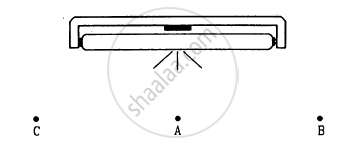Advertisements
Advertisements
Question
Two light sources of intensities 8 cd and 12 cd are placed on the same side of a photometer screen at a distance of 40 cm from it. Where should a 80 cd source be placed to balance the illuminance?
Solution
Total intensity of the 8 cd and the 12 cd light source is 20 cd.
Let d be the distance of the 80 cd source.
∴ Illuminance due to the 20 cd source (E1) is
\[E_1 = \frac{20}{\left( 0 . 4 \right)^2}..........(1)\]
∴ Illuminance due to the 80 cd source (E2) is
\[E_2 = \frac{80}{d^2}............(2)\]
As, E1 = E2
\[\therefore\frac{20}{\left( 0 . 4 \right)^2}=\frac{80}{d^2}\]
⇒ d = 0.8 m = 80 cm.
APPEARS IN
RELATED QUESTIONS
What is the luminous flux of a source emitting radio waves?
The luminous flux of a 1 W sodium vapour lamp is more than that of a 10 kW source of ultraviolet radiation. Comment.
The one parameter that determines the brightness of a light source sensed by an eye is ____________ .
Three light sources A, B and C emit equal amount of radiant energy per unit time. The wavelengths emitted by the three source are 450 nm, 555 nm and 700 nm respectively. The brightness sensed by an eye for the sources are XA, XB and XC respectively. Then, ________ .
An electric bulb is hanging over a table at a height of 1 m above it. The illuminance on the table directly below the bulb is 40 lux. The illuminance at a point on the table 1 m away from the first point will be about ___________ .
The intensity produced by a long cylindrical light source at a small distance r from the source is proportional to _________ .
A photographic plate is placed directly in front of a small diffused source in the shape of a circular disc. It takes 12s to get a good exposure. If the source is rotated by 60° about one of its diameter, the time needed to get the same exposure will be ___________ .
A point source of light moves in a straight line parallel to a plane table. Consider a small portion of the table directly below the line of movement of the source. The illuminance at this portion varies with its distance r from the source as ___________ .
Figure shows a glowing mercury tube. The intensities at point A, B and C are related as __________ .

The brightness-producing capacity of a source
(a) does not depend on its power
(b) does not depend on the wavelength emitted
(c) depends on its power
(d) depends on the wavelength emitted
A room is illuminated by an extended source. The illuminance at a particular portion of a wall can be increased by
(a) moving the source
(b) rotating the source
(c) bringing some mirrors in proper positions
(d) changing the colour of the source.
Mark the correct options.
(a) The luminous efficiency of a monochromatic source is always greater than that of a white light source of same power.
(b) The luminous efficiency of a monochromatic source of wavelength 555 nm is always greater than that of a white light source of same power.
(c) The illuminating power of a monochromatic source of wavelength 555 nm is always greater than that of a white light source of same power.
(d) The illuminating power of a monochromatic source is always greater than that of a white light source of same power.
The luminous flux of a monochromatic source of 1 W is 450 lumen watt−1. Find the relative luminosity at the wavelength emitted.
A source emits light of wavelengths 555 nm and 600 nm. The radiant flux of the 555 nm part is 40 W and of the 600 nm part is 30 W. The relative luminosity at 600 nm is 0.6. Find (a) the total radiant flux, (b) the total luminous flux, (c) the luminous efficiency.
A light source emits monochromatic light of 555 nwavelengthm. The source consumes 100 W of electric power and emits 35 W of radiant flux. Calculate the overall luminous efficiency.
Choose the correct answer from given options
Photo diodes are used to detect
